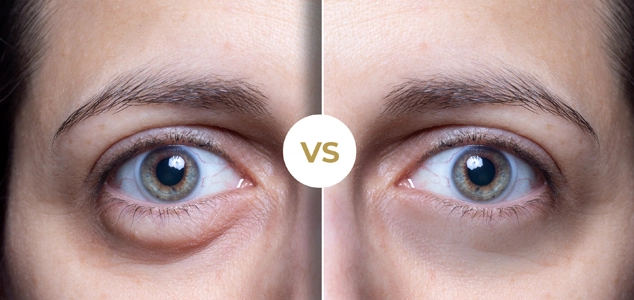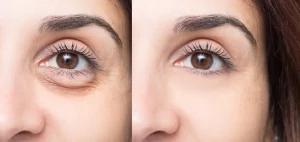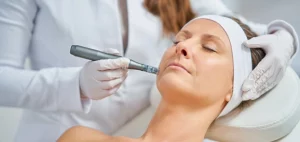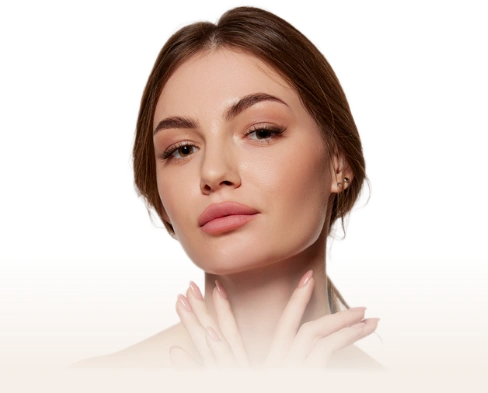Daily life is full of pressures, which often result in sleepless nights that strain not only our minds and bodies, but also our eyes in specific. It is critical to distinguish between eye bags, which suggest swelling around the eyes, and dark eye circles, which represent darkening of the skin beneath the eyes.
Have you ever found yourself in a state of irritation and desperation, continuously searching online for an answer to “how to eliminate dark circles and eye bags?”, in order to get rid of those pesky under-eye shadows that you’ve developed.
In today’s article we are going to give you detailed information on Eye Bags vs. Dark Circles, along with answering all the common queries.
Eye Bags vs. Dark Circle
What are Under Eye Bags?
Eye bags are gentle swelling or puffiness under the eyes that occurs with aging. As you become older, the muscles and tissues around your eyes decline. Your eyelids may appear swollen if normal fat that supports the eyes grows from the lower eyelid instead. Further, fluid may build in the region beneath your eyes, increasing the swelling.
What Causes Under Eye Bags
Eye bags are usually caused by aging, but there are several factors that may worsen it:
- Fluid discharge, specifically after awakening up.
- Poor sleep.
- Smoking, especially if one is a chain smoker.
- Different allergies.
- Genetics
- High salt intake
- Chronic medical conditions
What are Dark Circles?
Dark circles, also known as periorbital hyperpigmentation, are dark, discolored patches that form beneath the eyes. These circles are often distinguished by the appearance of shadows, pigmentation, or visible blood vessels, and they can be caused by a variety of circumstances, including heredity, aging, exhaustion, allergies, or skin conditions. Dark circles are a common cosmetic problem that can make the eyes look weary or old.
Both men and women are likely to develop dark circles under their eyes. They are sometimes accompanied by eye bags and have the ability to make you look more older and more exhausted than you actually are. Adding salt to injury, they can be rather difficult to remove from the surface.
What Causes Dark Circles?
The worst thing about dark circles that they can occur even in younger age, due to the following reasons:
- Fatigue
- Age
- Eye Strain
- Allergies
- Dehydration
- Sun overexposure
- Genetics
- Medical conditions like thyroid disease
Treatments for Under Eye Bags and Dark Circles
Several surgical and non surgical treatments are available for treating under eye bags and dark circles, some of the following non surgical procedures are:
1) Dermal Fillers:
Dermal fillers can address dark circles and under-eye bags by injecting hyaluronic acid or other appropriate fillers into the hollowed or sunken areas under the eyes. This plumps and fills up the depressions, eliminating shadows and smoothing the transition between the lower eyelids and cheeks. Furthermore, fillers can increase skin hydration and encourage collagen synthesis, resulting in a more refreshed and rejuvenated appearance for several months to a year or more.
2) Microneedling:
Microneedling can help with dark circles and under-eye bags by increasing collagen production, which thickens and strengthens the skin beneath the eyes. This reduces the visibility of underlying blood vessels that contribute to dark circles and improves general skin texture, reducing the appearance of fine lines and wrinkles caused by under-eye bags. Multiple sessions may be required for best results, and individual outcomes may differ.
3) PRP (Platelet Rich Plasma):
PRP therapy can treat dark circles and under-eye bags by stimulating collagen creation and improving the texture of the skin in the under-eye area using growth factors and platelets from the patient’s own blood. This procedure tightens the skin, potentially lowering the visibility of underlying blood vessels and resulting in a more youthful appearance with fewer dark circles and better skin texture. Multiple sessions may be required for best results, and individual outcomes may differ.
Treating with Syra Aesthetics
If you are already suffering from either of two and seeking the right provider then Syra Aesthetics is the right place for you to get consultation and decide which treatment would suit you best. Book your appointment today!

About The Author
Dr. Syra Hanif M.D.
Board Certified Primary Care Physician
Dr. Hanif is the Director of Aesthetic Medicine. She is a board-certified physician in Aesthetic Medicine who specializes in using non-surgical alternatives in order to enhance one's appearance through Botox and fillers.
Read More











